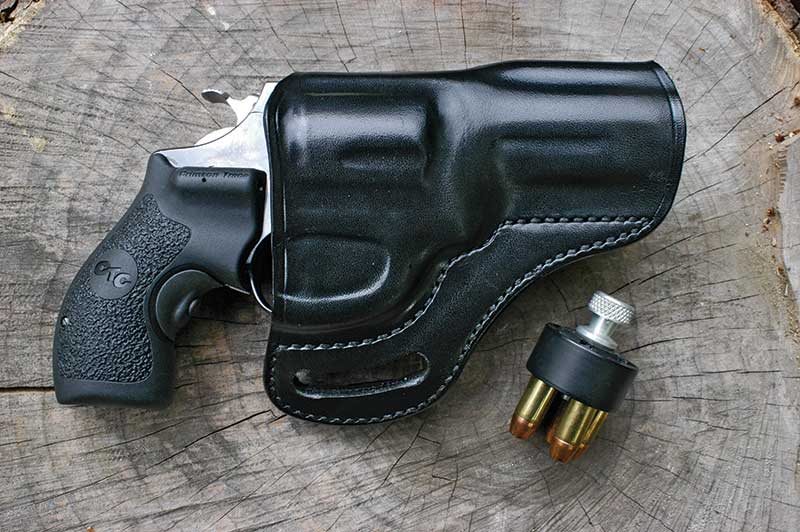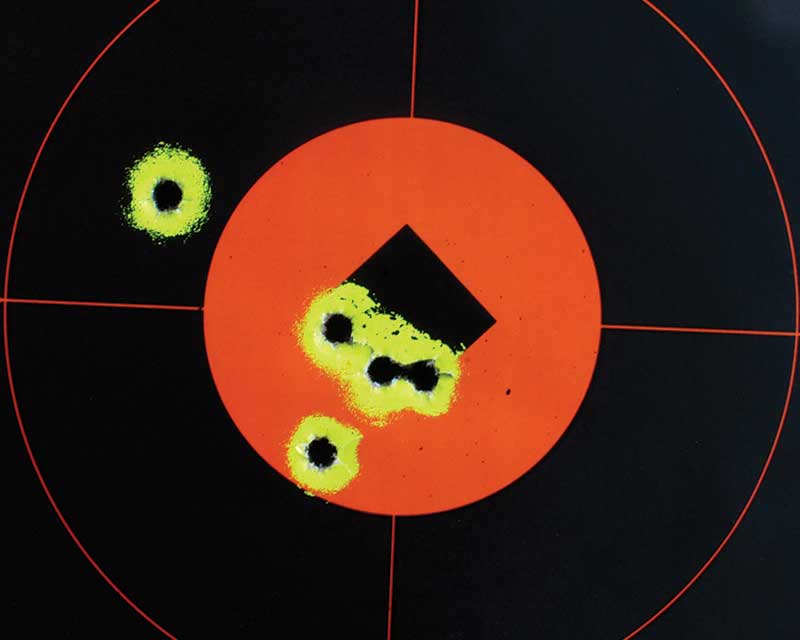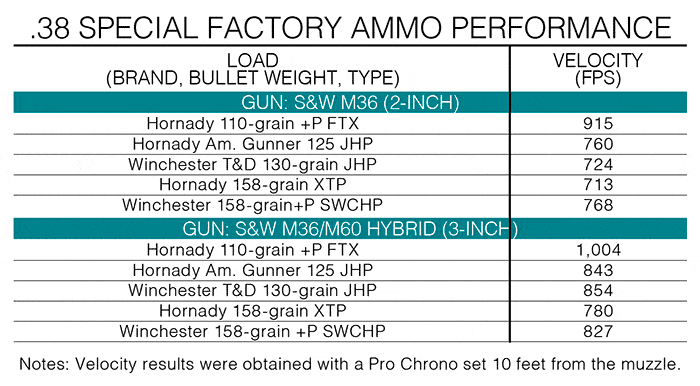“Semi” Snubbie
An Extra Inch Turns This J-frame Into “Something Special.”
I don’t quite remember how this whole 3-inch snubbie kick came about. Maybe it was because of my 3-inch Colt Detective Special—which my shooting buddy Thomas Mackie and I agreed was a heck of a lot easier to shoot well than the classic 2-inch version.
But since it is—essentially—a slightly “bobbed” 4-inch Police Positive, we both thought a smaller, more svelte J-Frame Smith would be just the ticket.
Plus, I just didn’t want to run that old Colt (circa 1967) hard. Snubbies require frequent TLC from experts if you use them a lot, and S&W tunemeisters are a heck of a lot easier to come by these days than guys conversant with long-discontinued Hartford products.
Thomas happened to own a Model 36 Chiefs Special and figured it would be far less expensive to find a stainless 3-inch full-lug barrel online than to simply get a current 3-inch Model 60. The project would be fun, educational, and keep us both out of trouble. And we both agreed a heavy barrel configuration would be the way to fly. Something to help settle the gun down quicker, maybe soak up a bit of recoil too.
Thomas is a machinist, metallurgist and an expert on all things “internal combustion,” including, naturally, firearms. His creative streak often comes into play. And it surely did this time:
“Let’s get a stainless J-frame cylinder too. I’ll bead-blast the add-on stuff and we’ll have a 2-tone 3-inch snubbie.” Next, in keeping with the 2-tone scheme, he picked up a replacement trigger and hammer—both hardchromed, but a close match for bead-blasted stainless. After a few problems with the replacement parts concerning ejector rod lengths and some internals in the trigger assembly, the whole thing came together.
Earlier, Thomas had installed a 3-inch barrel on an old blued all-steel Model 49 Bodyguard of his and was mightily pleased with it. He’d always remembered a local plainclothes cop many years ago who used to drop by his shop to talk guns and motorcycles. The officer’s carry gun was a rather rare bird—an S&W factory 3-inch M49—shrouded “cocking piece,” humpback configuration and all.
Thomas had lusted after one ever since, but they aren’t exactly easy to find these days. His “inched up” M49 sports an original factory 3-inch barrel he’d found online and a walnut set of excellent German-crafted Nill stocks, very unobtrusive yet comfortable even with heavier loads. Other than that, the M49 is dead stock.
OK. By now you’re probably thinking, what’s in an inch among J-Frames? Well, a lot more than you’d expect when you go from 2 to 3 (actually, it’s more accurate to say from 1-7/8 to 3). Although there’s no real difference in inherent accuracy, an extra inch of sight radius makes the gun quite a bit more forgiving. And then, of course, there’s the velocity boost. Would it be as much as going from 3 to 4 inches? Would it split the difference between 2 and 4 inches? And if so, with what loads and bullet weights?
There were a couple of other touches for the two-tone M36 project. Thomas is pretty much of an old-style shooter and prefers to shoot double-action revolvers in the single-action mode. Yes, I know it flies in the face of revolver wisdom. But it makes him happy.
At heart he’s a 1911 guy and would go to one of those if he ever felt the need for speed. He basically sees a 3-inch J-Frame as a trail gun (as well as a gun you’re likely to have instant access to when you need one). So he decided to do something about the replacement hammer. He was unhappy with the skimpy hammer spur and wanted to replicate an old target-type hammer—something roughly along the lines of a Colt Python.
So Thomas welded stainless “wings” to the existing spur, broadening it to a 1/2-inch across. Then re-shaped and coarsely re-checkered it. The result is eminently “thumb-cockable.”
Me? I spent the last 15 years studiously avoiding thumb-cocking a defensive revolver. But there is no way I would want to give up the option for it. Which is why I’m a bit leery over the hammerless guns.
We also put on a pair of Crimson Trace Lasergrips. Having a “low light/no light” sighting option which does nothing to change the gun’s profile—or add significant weight—always classifies as a “good thing.”
Then there was the question of carry. We both agreed on a cross-draw black Galco Hornet belt rig over an IWB setup. The Hornet housed both the 3-inch bull barrel hybrid and the Model 49 perfectly. It keeps both guns snug, accessible and it looks good.
We picked a fairly representative cross-section of the types of factory ammo in the “personal defense sphere—light (110 grain), medium (125 to 130 grain) and heavy (158 grain). It included Hornady 110-grain +P FTX, Hornady American Gunner 125-grain JHP, Hornady 158-grain XTP, Winchester Defend 130-grain JHP and Winchester 158-grain +P SWCHP (the storied “FBI Load”).
We then took both 3-inch guns to the range along with a stock 2-inch barreled M36 Ladysmith for chrono comparison. Using the hybrid two-tone 3-inch, we were pleasantly surprised at how much an inch difference made velocity-wise. Plus, the bull-barreled 3-inch with Crimson Trace LaserGrips was considerably more comfortable to shoot than the 2-inch Ladysmith, particularly with the heavier loads.
We wanted to check the sights on both 3-inch guns to determine if barrel cranking or front sight work was needed to bring either into line. This we did at 30 feet, using the old Winchester FBI Load. The Model 49 was perfect—it hit right at the top of the front sight. This really made Thomas happy. The 158’s are his first choice for anything “.38 Special.”
The two-tone Model 36 shot quite a bit low, but the windage was fine. Then we started using the LaserGrips, and after a few cranks on the W and E adjustments, we were doing nearly as well with the red dot from the hip as we had with the M49. Perhaps we’ll get the front sight height right on it next. But with the LaserGrips up and running, it’s not a deal-breaker.
We were so tickled with both guns I kind of let it go to my head and tried a dozen or so rounds double action at a 100-yard steel gong with the M49. Even hit it a couple of times with a 12-o’clock hold. I don’t recall ever doing that well with a 2-inch snubbie.
Maybe there really is something to the sight-radius advantage of an extra inch. Considering the significant gains in velocity and shootability, plus the relatively insignificant price in concealability, the 3-inch .38 snubbie really does seem like the way to go.
By The NumbersThe Ballistic Bump
85.6 fps—The average increase in muzzle velocity in the 3-inch barrel over the 2-inch barrel from all five loads.
130 fps—The largest velocity gain from a 3-inch barrel over a 2-inch. The load? Winchester Defense 130-grain JHP.
59 fps—The smallest increase in velocity between the 3- and 2-inch barrel was with Winchester’s 158-grain +P SWCHP “FBI Load.”
20 fps—The increase in muzzle velocity from a 4-inch S&W M15 over a 3-inch M36/M60 using Hornady American Gunner 125-grain JHP.
83 fps—The increase in muzzle velocity from a 3-inch barrel over a 2-inch barrel with American Gunner 125’s.
Different chrono setups, barometric conditions, ambient temperatures and the various guns themselves all provide variables accounting for discrepancies between what you read on your ammo box and what you see on the screen of your personal chrono. Plus, actual revolver barrels and factory “pressure barrels” of identical length seldom agree on velocity figures. One thing you can measure is barrel/ cylinder gap. The barrel/cylinder gap of the 2-inch S&W is 0.012-inch, the rebarreled 3-inch gap 0.009, and the control S&W Mod 15 0.011- inch.
Shooting Facilities provided by:
Angeles Shooting Ranges
12651 Little Tujunga Rd.
San Fernando, CA 91342
(800) 499-4486
www.angelesranges.com
Crimson Trace Corp.
9780 SW Freeman Dr., Wilsonville,OR 97070
(800) 442-2406
www.crimsontrace.com
Galco International
2019 W. Quail Ave., Phoenix, AZ 85027
(800) 874-2526
www.galcogunleather.com

Get More Revolver Content Every Week!
Sign up for the Wheelgun Wednesday newsletter here:










